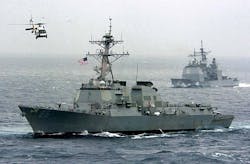Navy seeks to double funding for Advanced Above Water Sensors shipboard radar research
The Navy's proposed 2017 budget, released this week, asks Congress for $85.9 million next year for the Advanced Above Water Sensors research and development, which is nearly double the $43.9 million these programs received this year. Federal fiscal year 2017 begins next October 1.
The Advanced Above Water Sensors line item in the 2017 Navy budget includes programs like the Air and Missile Defense Radar (AMDR); the Periscope Detection Radar program; Dual Band Radar Upgrades; Multi-Mission Signal Processor (MMSP); and the Advanced Radar Technology (ART); Improved Capabilities for SPY-1 Radar.
The AN/SPY-6 Air and Missile Defense Radar is being developed by Raytheon Co. for integrated air and missile defense for several different ship classes. This suite consists of an S-band radar (AMDR-S), an X-band radar and a Radar Suite Controller (RSC).
AMDR simultaneously will support long-range exoatmospheric detection, tracking and discrimination of ballistic missiles, as well as area and self defense against air and surface threats.
Related: Navy orders 12 advanced AN/SPQ-9B shipboard radar systems from Northrop Grumman
Ballistic missile defense requires increased radar sensitivity and bandwidth compared with traditional surface ship radar systems. Area air defense and self defense, meanwhile, requires increased sensitivity and clutter rejection to detect and defeat low-flying threats like sea-skimming cruise missiles in the presence of heavy land, sea, and rain clutter.
The Periscope Detection Radar project is developing a fast-scanning radar system able to detect and classify submarine periscopes, and separate detected periscopes popping up just above the ocean's surface from surface contacts, buoys, small boats, floating mines, and similar objects.
This effort is developing the Periscope Detection and Discrimination (PDD) interface for the AN/SPQ-9B radar. The AN/SPQ-9B is an X-Band, pulse Doppler, frequency agile radar with high clutter rejection for coastal waters and other high-radar-clutter environments.
The AN/SPQ-9B also scans out to the horizon to detect air and surface targets, as well as to track low-flying anti-ship cruise missiles, surface threats, and low-and-slow aircraft like helicopters and unmanned aerial vehicles (UAVs).
Dual-band radar upgrades will modify volume search radar systems for cost savings and ease of maintenance. It seeks to provide system upgrades and technology insertion for multi-function dual-band radar on new Ford-class aircraft carriers and on Zumwalt-class land-attack destroyers.
Related: Microwave Applications phase shifters chosen for passive electronically scanned array radar
Upgrades involve radar hardware and software including radar arrays, receiver/exciters, signal data processors, radome, power subsystems, and electronics thermal management.
The Multi-Mission Signal Processor technology provides anti-air warfare and ballistic missile defense multi-mission capability for Arleigh Burke-class destroyers as part of the Aegis Modernization Program.
It modifies SPY-1D transmitters to enable dual beam for reduced frame times and better reaction time. MMSP improves performance in littoral, ducted clutter environments, and in electronic attack, and chaff environments and improves commonality in computer programs and equipment.
Advanced Radar Technology (ART) seeks to develop and integrate existing and new radar technologies into the Navy's sensors to enhance performance and ensure sensor operations and sustainment.
The Improved Capabilities for SPY-1 Radar project is to reduce cascading failures, mitigate obsolescence issues, and improve reliability anti-air warfare and ballistic missile defense.

